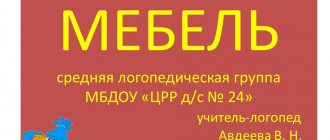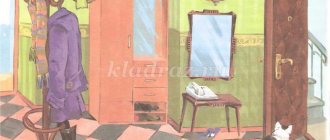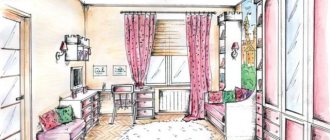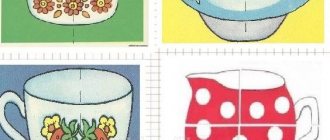Card index of tasks on the lexical topic “Furniture”
Recommendations for parents on the lexical topic: “Furniture”
Children must learn: the names of the main types of furniture and their parts; appointment.
Vocabulary
Vocabulary expansion:
NOUNS: furniture, chair, stool, table, bed, sofa, armchair, wardrobe, legs, tabletop, back, seat, armrests, door, shelves, living room, bedroom, kitchen, leg, room, hanger; chest of drawers, sideboard, buffet, wall, nightstand.
ADJECTIVES: dining, writing, magazine, computer, furniture, kitchen, wardrobe, tall, large, small, round, long, beautiful, smooth, shiny, comfortable, wooden, light, wicker, iron, soft, hard, fashionable, room, book; oak, birch, walnut, pine, soft, mirror, leather, polished, plastic.
VERBS: do, sell, purchase, install, bring in, take out, move, sit, sleep, lie, clean, wipe, take care of, dream, rest, play, store, hang, stand, sleep, work, open, wipe, break, repair; arrange.
ADVERBS: comfortable, soft, hard, right, left, middle.
Grammatical structure
1. “One is many” (use of singular and plural nouns)
Table - tables (bed, sofa, chair, wardrobe, chest of drawers, sideboard, nightstand, shelf, armchair, rack, stool, couch, sink)
2. “Call it affectionately” (formation of nouns in a diminutive form)
Table - table (bed, sofa, chair, wardrobe, chest of drawers, sideboard, nightstand, shelf, armchair, rack, stool, couch, sink)
3. “How many are there?” (agreement of numerals with nouns in gender, number and case):
One table, two tables, three tables, four tables, five tables (bed, sofa, chair, wardrobe, chest of drawers, sideboard, nightstand, shelf, armchair, rack, stool, couch, sink)
4. “What is this for?” (use of complex sentences with the conjunction “in order to”)
What is a chair for? A chair is needed to sit (teach children to answer in complete sentences)
(bed, sofa, chair, wardrobe, chest of drawers, sideboard, nightstand, shelf, armchair, rack, stool, couch, sink)
5. “Find the right part” (learning the preposition for)
The lid is needed for ... (table)
The backrest is needed for...(table, chair, armchair, sofa). The door is needed ... for (cabinet, bedside table)
Drawers are needed for ... (table, bedside table, chest of drawers)
The mattress is needed for... (bed)
Armrests are needed for... (chair, sofa)
6. “What is the furniture made of?” (formation of relative adjectives)
| Furniture made of leather - leather Wooden furniture - … Furniture made of plastic -... Furniture is woven -... Furniture made of plastic -... Metal furniture -.. | Wooden table – wooden table Leather sofa – leather sofa Bookshelf – bookshelf Oak chest of drawers – oak chest of drawers Table in the kitchen - Shoe shelf – |
7. Use of plural nouns in the genitive case
Chair - no chair
Sofa - no sofa
Bed – no bed
Desk – no desk, etc.
Connected speech
1. Compiling a story - description “We are furnishing a room (living room, bedroom, kitchen)” Use prepositions: in, under, on, above, about, for; adverbs: right, left, middle, etc.
2. Compiling a story “How I cleaned the room.”
3. Draw your room.
Final event: presentation of the description story “Furnishing the room”
Dear parents! If you have furniture for toys (rubber, wood, plastic), please bring it on Thursday. You can take her home on Friday. Thank you for your cooperation!
Riddles on the theme "Furniture"
| There are four legs under the roof, and on the roof there is soup and spoons. (Table) You can sit on it if you are invited to the table to eat. (Chair) They write on me and eat on me, Children are all sitting around (Table) They nailed it to the wall deftly, Now I have become... (Shelf) If you are tired of playing, then lie down on... (Bed) During the day he sleeps on it with a blanket and pillow, and at night Andryushka sleeps there. (Bed) The day has passed, it’s time to sleep, I’ll spread out my... (Bed) How nice it is for our Tanya to lie on... (Sofa) Standing in front of the TV, Dad lies on it, resting. (Sofa) | I look a little like a table, I have it in the kitchen and in the hallway, I’m rarely in the bedroom, But my name is... (Stool) I’ll save your things and put them on the shelves. I'm tall like a giraffe Guess who I am... (Wardrobe) It looks like a sofa And a little like a chair too. It's cramped for the two of us to sit in it. Did you guess it? This... (Chair) Four sisters sit under one roof all day long. (Table and chairs) Nikolka made it yesterday for his toys... (Shelf) In our park on the alley there are openwork... (Benches) Sweater, jacket, warm scarf Carefully fold in... (Wardrobe) Clean Lyubochka Always has order in... (Bedside table) |
| Finger | gymnastics |
Finger gymnastics “Lots of furniture in the apartment”
One two three four,
Lots of furniture in the apartment. We rhythmically clench and unclench our fists.
We'll hang the shirt in the closet,
And we’ll put a cup in the cupboard.
To give your legs a rest,
Let's sit on the chair for a while. We bend our fingers, starting with the big ones, for each name of the furniture.
And when we were fast asleep,
We were lying on the bed.
And then me and the cat
We sat at the table.
We drank tea and jam together
There is a lot of furniture in the apartment. Rhythmically, we alternately clap our hands and knock our fists.
Kiryushkina's crib
Here is Kiryushka’s crib, (They spread their arms to the sides.) So that Kiryushka sleeps sweetly, (They squat, put their folded palms under his left cheek.) So that in his sleep he grows up, (They rise slowly.) So that he becomes big quickly. (Stand on tiptoes, stretch arms up.)
Wardrobe
They bought me a roomy, large wardrobe for my clothes. (Shows how big the closet is.)
It is beautiful and comfortable and is called “wardrobe”. I’ll put clothes in it: T-shirts, shorts and panties, Trousers, jackets and shirts, (Bends fingers on both hands.) Sweaters and jackets. And I’ll put the socks and T-shirts on the shelves.
Table
The table has four legs. (The left fist is placed on the table.) The lid is on top, like a palm. (Cover the top of the fist with the palm of your right hand.)
Chair
This is a chair. Seat, back, (fist, palm) And on the back there are two pictures, (shows 2 fingers) And four more legs, (shows 4 fingers) for the cat to sit under the chair. (show ears)
Legs, back (The left hand rests its elbow on the table.) And the seat (The fist is pressed to the left palm.) Here's a chair for you. Surprisingly!
Furniture coloring pages
Games on the theme “Furniture”:
Where is the kitten sitting?
“Match pieces of furniture according to the pattern”
Where should you put the toys?
Where do we hide the dog (cat, car, slippers, mouse)?
Tell me who sits where?
Where did the kitten go?
Where does the bear sit?
Name the pieces of furniture.
What is missing?
Developing coherent speech
Trace along the dotted lines (develop fine motor skills)
Lesson summary for the senior group of kindergarten with presentation. Furniture
Summary of the lesson on the formation of the lexical-grammatical system of the language in the senior group of combined orientation
Author: Vasilenkova Tatyana Sergeevna Topic: “Let's help the Siberian” Age group of children: senior group (5 – 6 years old) Speech conclusion: ONR (III level) Purpose: Create conditions for expanding and consolidating children’s knowledge on the topic “Furniture”. Objectives: 1. Correctional and educational:
Clarify, expand and activate the vocabulary on the topic “furniture”;
develop the ability to classify, compare and generalize; consolidate the ability to use words that have opposite meanings; improve the ability to form words with diminutive suffixes; continue to practice children in coordinating words in a sentence; learn how to correctly assemble an image of an object from individual parts. 2. Correctional - developmental:
Develop verbal memory, develop verbal-logical thinking, develop visual perception and coherent speech;
develop curiosity and a positive attitude towards the learning process. 3. Correctional and educational:
To develop children’s skills of cooperation and goodwill;
develop the ability to work and play in a team. Dictionary: pencil case, chest of drawers, hard Integration of educational areas: cognitive development, speech development, social and communicative development. List of types of activities and corresponding forms of work: communicative activities (conversation, riddles, word games), gaming activities (didactic and verbal games), motor activities (physical exercises, ball games). Expected result: Children will learn to generalize the concept of “furniture” and expand their vocabulary on this topic. They will learn to classify, compare and generalize pieces of furniture, use words that have opposite meanings; will learn to form words with diminutive suffixes. Children will practice matching words in a sentence. Learn how to correctly assemble a whole from parts. Equipment: Multimedia, speakers, laptop, spinning top, envelope, letter in the shape of a cone from Siberian, cut-out picture of 6 parts, massage ball, music for physical exercises, video recording of Siberian.
Progress of the lesson
I. Org. moment Greeting - Our top spun and invited the guys to the circle. Let's hold hands together, we'll smile at everyone around us. II. Main part - Guys, today I didn’t come to you empty-handed, I have a letter for you from Siberian! Do you know the fairy tale about the Siberian, who is he? (Siberian is a boy who emerged from a cone, he lives in Siberia, and Siberia is our small Motherland.) - So, listen to what Siberian writes: “Hello, guys! My friend sent me a photo of his room, which he decorated with new furniture. But the photograph fell into pieces, I really want to see it, but I can’t collect it, because a strong wind blew and the pieces scattered in different directions. Please help me find all the parts of the photo and assemble it!” — Guys, can we help the Sibiryachka? (Yes) - How can we help collect the photograph? - We need to find all the parts of the photograph, but in order to find each of the parts, we need to complete tasks, remembering the furniture! - Wait, there’s something else in the envelope... I think this is a hint where you can find the next part of the photo. — The next part of the photo is in the place where you are doing physical exercises. Guys, let's go look for part of the photo there. In the physical development corner, children find part of a photograph, on the back of this part there is a task: guess the riddles - If the answer is correct, the answer will appear on the screen. 1. Riddles. There is a back, but it never lies. Has four legs, but doesn't walk. He himself always stands, but tells others to sit. (Chair) I am comfortable, very soft, It’s not difficult for you to guess - Grandmothers and grandchildren love to sit and lie down. (Sofa) At dawn and sunset He sleeps sweetly on... (Bed) Four brothers stand under one hat. (Desk) - You’ve guessed the riddles, but how can you call all these objects in one word? (Furniture) - Guys, there is also a hint here: “The third part of the photo is in the corner of the bee” - Well done guys, you found it quickly! Now you need to complete the task, look at the screen. What's missing here? Why? 2. Didactic game “The fourth odd one” On the screen - We looked at the pictures, our eyes are tired, let's relax them. 3. Gymnastics for the eyes “The eyes need a rest.” (Guys close their eyes)
“You need to take a deep breath.”
(Deep breath. Eyes still closed)
“The eyes will run in circles.”
(Eyes are open. Movement of the pupil in a circle clockwise and counterclockwise)
“They will blink many, many times”
(Frequent blinking of the eyes)
“The eyes feel good.”
(Lightly touch closed eyes with fingertips)
“Our eyes will see everything!”
(Eyes are wide open. There is a wide smile on the face)
- Our eyes have rested, and it’s time for us to find the 4th part of the photo.
Let's see the hint. - The next part is where you like to draw. — Guys, is there a place where you like to draw? - Well done! And we found this part too! Now you need to complete the task. - Finish the sentence with the opposite word, for example, the closet is high, and the chest of drawers... 4. Exercise “Say the opposite” : - The closet is high, and the chest of drawers... is low. — The table is large, and the bedside table... small. - The sofa is soft, but the stool... hard, hard. We repeat the new word hard. — The stool is hard, but the chair is... soft. - The bedside table is low, and the closet is... high. “We were just playing with you and we’re a little tired, let’s warm up!” 6. Physical exercise “Furniture” In the morning we’ll go to the store, (walk in place)
We’ll buy furniture there: A tall wardrobe
(stand on tiptoes, stretch arms up)
And a stool,
(squat)
Bed - we’ll sleep on it
(put folded palms under the left cheek)
Let’s buy a chair
(the bent left palm is attached to the straight right palm to form a “chair”)
And a large table
(they spread their arms to the sides)
Let’s take them home quickly
(they turn the steering wheel)
- We warmed up, rested, but we still need to find one part, look at the hint!
— The 5th part is in the place where you learn to speak beautifully, work with a speech therapist. - Well done! Now we have 5 parts of the photo. Let's complete the task. - I’ll throw the ball to you and name the object, and you, returning the ball to me, call the object affectionately, for example, “I have a chair, and you?” (To the armchair.) 5. Game “Name it kindly” (with a ball) - I have a sofa, what about you? (Sofa.) - I have a closet, what about you? (Cabinet.) - I have a chair, what about you? (Chair.) - I have a table, what about you? (Table). We really can’t wait to help Siberian see a photo of the new furniture in his friend’s room. — The 6th part is in a place where you like to make buildings. Let's go look. - Okay, well done, let's complete the task. “I’ll read the sentence to you, and you listen, maybe there’s something wrong with it?” Is there an error? 7. Exercise “Fix me” - I bought a beautiful wardrobe. — I bought a new sofa. — I bought a comfortable chair. — I bought a black table. - I bought a big bed - Oh, what good guys, they’ve already found all the parts! Guys, we completed all the tasks, and found all the fragments of the photograph of the room with furniture. - What do you think remains for us to do? (Collect) We collect the photo and specify what furniture is in this photo. - How to call all these objects in one word? III. Result - Guys, did we help the Siberian?
- What did you and I do for this? - Look at the screen. Recording of the Siberian, he thanks the children. - I’m giving you a gift from Sibiryachka, and I also want to thank you, you are so great, it was very pleasant for me to communicate with you! Goodbye! Presentation on the topic: Furniture. Lesson in the senior group of kindergarten
We recommend watching:
Summary of educational activities in the senior group “Journey to a Fairy Tale” Summary of a mathematics lesson for children of the senior orthopedic group Summary of educational and gaming activities in the senior group in the section of the “Childhood” program Synopsis of educational activities for the perception of music in the senior group of kindergarten
Similar articles:
Lesson in the senior group of kindergarten on the topic of February 23
Lesson notes for children of senior preschool age. Topic: Invisible air
Summary of organized educational activities for children of the senior group
Notes for mathematics classes in the senior group
Lesson summary on the topic “Reserve” in the senior group



